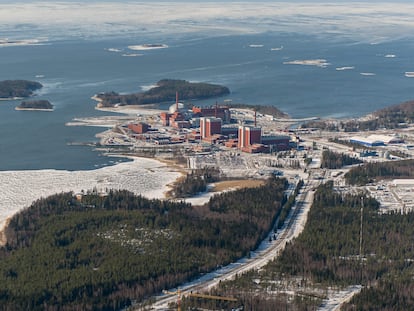This is how Finland is looking for its next Nokia
Sari Multala — the minister of Science and Culture for the Nordic country — wants to boost public and private investment in R&D to 4% of GDP. She says that this will allow small and medium-sized enterprises to ‘have the success’ that the mobile manufacturer Nokia once enjoyed

In Finland — as in almost the entire world — it’s known that investing in science improves the quality of jobs in an economy, while increasing the added value of exports. And it’s also known that these positive results don’t simply materialize in the four or five years between election cycles.
While many countries avoid this reality, successive governments in Finland have bet on the long-term results of science. Spending on research and development — both in the public and private sectors — today represents nearly 3% of GDP, twice as much as in other high-income countries, such as Italy and Spain.
According to Minister of Science and Culture Sari Multala – appointed by the new conservative administration of Prime Minister Antti Petteri Orpo – the underlying reason for this steady investment in R&D has always been to improve productivity. In an interview with EL PAÍS during her trip to Madrid, she affirms that “the knowledge acquired by science is used by companies to make innovations in collaboration with universities.”
“In Finland, we realized that, in terms of economic growth, we were behind most of the countries which we were competing with,” explains Multala, who, before entering politics, was an Olympic sailor. “We also had the challenge of being — after Italy — the country with the second-oldest population in Europe, which meant that we were losing our working-age population.” For Multala, the logical conclusion of these two conditions was the need to “act quickly” by investing in science and education “to reactivate the economy and increase productivity.”
But something seems to be missing in Multala’s reasoning: how did the Finns manage to get around the short-term thinking? “We understood that science and education were not only ways to build the foundations of economic growth in the medium and long-term, but that, in the short-term, they also served to send a signal to companies, so that they could understand that there’s a commitment from the government. This gives them security to also undertake their own investments in research and development,” the minister responds.
Stoicism and some luck
To fully understand her answer, perhaps we have to examine the humility that is characteristic of the Finns. In Europe, one of the stereotypes associated with them is that they’re known to practice stoicism, while having an ability to grow in times of adversity. This actually has its own word in Finnish: susi (“strength” or “perseverance”).
But does luck have anything to do with their success? After all, the Nokia Corporation — which, for years, was the engine of the Finnish economy — wasn’t dedicated to the development of microchips or pharmaceutical products (to name two traditionally coveted sectors), but, rather, to mobile devices… an industry whose growth in recent decades has exceeded all expectations.
The growth of the mobile sector, the risky and successful commitment to the GSM communications standard, as well as the undisputed leadership of Nokia until the arrival of the iPhone (presented by Steve Jobs in 2007) contributed to 21% of Finnish exports in 2000. That year, four out of every 10 mobile phones sold around the world were from the Nokia brand. “Of course, there’s always luck in everything, but it’s also true that, in the 1990s, there was already a research and development ecosystem in Finland,” Multala notes. “And Nokia is one of the success stories that this system generated.”
Unfortunately, the company is also one of the stories that explain the Finnish collapse after the popularization of smartphones, which use technology from Google and Apple. According to estimates by the Finnish Economic Research Institute (ETLA), between 1998 and 2007, 25% of Finland’s GDP growth was due to the Nokia Corporation. Hence, its fall contributed to the 8.1% decline that the Finnish economy recorded in 2009, according to data from the World Bank.
Research and development hasn’t yet recovered the cruising speed of 3.54% of GDP that it had in 2008, which reached such a high level thanks to the phenomenal contribution of Nokia’s research. According to Multala, the current government has proposed rebuilding that scheme “by [ensuring that] official research institutes further promote collaboration between companies and universities.”
“The objective of [the next] four years is that there aren’t so many borders between science developed by universities and science developed by the private sector. [We want to ensure] that, by 2030, the research and development of both sectors reaches a combined total of 4% of GDP,” she adds. The latest data — according to World Bank estimates — notes that 2.91% of Finland’s GDP was dedicated to R&D. In countries such as Italy and Spain, the percentage for that year stood at 1.53% and 1.41% respectively.
Although infinitely less important than a couple of decades ago, Nokia is still active in the telecommunications sector, specializing in network and telephone infrastructure, while also developing routers, smart lights and smart televisions, among other products. In recent years, Finland has also developed other smaller Nokias, such as those responsible for the Wolt food delivery application, the multinational elevator company Kone, or Rovio, the creator of the popular video game Angry Birds (which was acquired by the Japanese multinational Sega this year). For the near future, the bet is to grow exponentially by creating digital solutions for health services and clean energy firms.
“The goal of our investment in research and development is to empower many small and medium-sized companies, so that they can have the success that Nokia once enjoyed,” Multala emphasizes. “And, of course, having many different businesses which are successful and growing provides a much more secure and stable foundation for the country’s growth.”
Another sector related to R&D is defense. After joining NATO this past April, Finland committed to raising its military spending to 3% of GDP, above the 2% required of member countries in the military alliance. Will this mean another boost for the Finnish science sector? Multala admits that there’s a relationship between science and weapons, but she doesn’t believe that membership in NATO will offer an economic stimulus in the short-term. “The investments are going to come more in terms of equipment renewal and through the Air Force,” she concludes.
Sign up for our weekly newsletter to get more English-language news coverage from EL PAÍS USA Edition
Tu suscripción se está usando en otro dispositivo
¿Quieres añadir otro usuario a tu suscripción?
Si continúas leyendo en este dispositivo, no se podrá leer en el otro.
FlechaTu suscripción se está usando en otro dispositivo y solo puedes acceder a EL PAÍS desde un dispositivo a la vez.
Si quieres compartir tu cuenta, cambia tu suscripción a la modalidad Premium, así podrás añadir otro usuario. Cada uno accederá con su propia cuenta de email, lo que os permitirá personalizar vuestra experiencia en EL PAÍS.
¿Tienes una suscripción de empresa? Accede aquí para contratar más cuentas.
En el caso de no saber quién está usando tu cuenta, te recomendamos cambiar tu contraseña aquí.
Si decides continuar compartiendo tu cuenta, este mensaje se mostrará en tu dispositivo y en el de la otra persona que está usando tu cuenta de forma indefinida, afectando a tu experiencia de lectura. Puedes consultar aquí los términos y condiciones de la suscripción digital.
More information
Archived In
Últimas noticias
Most viewed
- Sinaloa Cartel war is taking its toll on Los Chapitos
- Oona Chaplin: ‘I told James Cameron that I was living in a treehouse and starting a permaculture project with a friend’
- Reinhard Genzel, Nobel laureate in physics: ‘One-minute videos will never give you the truth’
- Why the price of coffee has skyrocketed: from Brazilian plantations to specialty coffee houses
- Silver prices are going crazy: This is what’s fueling the rally










































